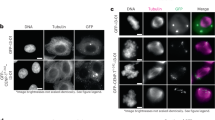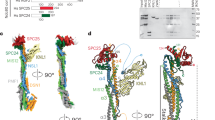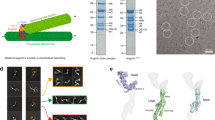Abstract
Chromosomes must be accurately partitioned to daughter cells to prevent aneuploidy, a hallmark of many tumors and birth defects. Kinetochores are the macromolecular machines that segregate chromosomes by maintaining load-bearing attachments to the dynamic tips of microtubules. Here, we present the structure of isolated budding-yeast kinetochore particles, as visualized by EM and electron tomography of negatively stained preparations. The kinetochore appears as an ~126-nm particle containing a large central hub surrounded by multiple outer globular domains. In the presence of microtubules, some particles also have a ring that encircles the microtubule. Our data, showing that kinetochores bind to microtubules via multivalent attachments, lay the foundation to uncover the key mechanical and regulatory mechanisms by which kinetochores control chromosome segregation and cell division.
This is a preview of subscription content, access via your institution
Access options
Subscribe to this journal
Receive 12 print issues and online access
$189.00 per year
only $15.75 per issue
Buy this article
- Purchase on Springer Link
- Instant access to full article PDF
Prices may be subject to local taxes which are calculated during checkout




Similar content being viewed by others
References
Pfau, S.J. & Amon, A. Chromosomal instability and aneuploidy in cancer: from yeast to man. EMBO Rep. 13, 515–527 (2012).
Compton, D.A. Mechanisms of aneuploidy. Curr. Opin. Cell Biol. 23, 109–113 (2011).
Santaguida, S. & Musacchio, A. The life and miracles of kinetochores. EMBO J. 28, 2511–2531 (2009).
Cheeseman, I.M. & Desai, A. Molecular architecture of the kinetochore-microtubule interface. Nat. Rev. Mol. Cell Biol. 9, 33–46 (2008).
Takeuchi, K. & Fukagawa, T. Molecular architecture of vertebrate kinetochores. Exp. Cell Res. 318, 1367–1374 (2012).
DeLuca, J.G. & Musacchio, A. Structural organization of the kinetochore-microtubule interface. Curr. Opin. Cell Biol. 24, 48–56 (2012).
Westermann, S., Drubin, D.G. & Barnes, G. Structures and functions of yeast kinetochore complexes. Annu. Rev. Biochem. 76, 563–591 (2007).
Zinkowski, R.P., Meyne, J. & Brinkley, B.R. The centromere-kinetochore complex: a repeat subunit model. J. Cell Biol. 113, 1091–1110 (1991).
Joglekar, A.P. et al. Molecular architecture of the kinetochore-microtubule attachment site is conserved between point and regional centromeres. J. Cell Biol. 181, 587–594 (2008).
Cheeseman, I.M., Chappie, J.S., Wilson-Kubalek, E.M. & Desai, A. The conserved KMN network constitutes the core microtubule-binding site of the kinetochore. Cell 127, 983–997 (2006).
Hofmann, C. et al. Saccharomyces cerevisiae Duo1p and Dam1p, novel proteins involved in mitotic spindle function. J. Cell Biol. 143, 1029–1040 (1998).
Li, Y. et al. The mitotic spindle is required for loading of the DASH complex onto the kinetochore. Genes Dev. 16, 183–197 (2002).
Welburn, J.P. et al. The human kinetochore Ska1 complex facilitates microtubule depolymerization-coupled motility. Dev. Cell 16, 374–385 (2009).
Hanisch, A., Sillje, H.H. & Nigg, E.A. Timely anaphase onset requires a novel spindle and kinetochore complex comprising Ska1 and Ska2. EMBO J. 25, 5504–5515 (2006).
Asbury, C.L., Tien, J.F. & Davis, T.N. Kinetochores′ gripping feat: conformational wave or biased diffusion? Trends Cell Biol. 21, 38–46 (2011).
Schittenhelm, R.B. et al. Spatial organization of a ubiquitous eukaryotic kinetochore protein network in Drosophila chromosomes. Chromosoma 116, 385–402 (2007).
Joglekar, A.P., Bloom, K. & Salmon, E.D. In vivo protein architecture of the eukaryotic kinetochore with nanometer scale accuracy. Curr. Biol. 19, 694–699 (2009).
Wan, X. et al. Protein architecture of the human kinetochore microtubule attachment site. Cell 137, 672–684 (2009).
Welburn, J.P. & Cheeseman, I.M. Toward a molecular structure of the eukaryotic kinetochore. Dev. Cell 15, 645–655 (2008).
McIntosh, J.R. et al. Fibrils connect microtubule tips with kinetochores: a mechanism to couple tubulin dynamics to chromosome motion. Cell 135, 322–333 (2008).
Dong, Y., Vanden Beldt, K.J., Meng, X., Khodjakov, A. & McEwen, B.F. The outer plate in vertebrate kinetochores is a flexible network with multiple microtubule interactions. Nat. Cell Biol. 9, 516–522 (2007).
Johnston, K. et al. Vertebrate kinetochore protein architecture: protein copy number. J. Cell Biol. 189, 937–943 (2010).
Brinkley, B.R. & Stubblefield, E. The fine structure of the kinetochore of a mammalian cell in vitro. Chromosoma 19, 28–43 (1966).
Jokelainen, P.T. The ultrastructure and spatial organization of the metaphase kinetochore in mitotic rat cells. J. Ultrastruct. Res. 19, 19–44 (1967).
Roos, U.P. Light and electron microscopy of rat kangaroo cells in mitosis. II. Kinetochore structure and function. Chromosoma 41, 195–220 (1973).
Rieder, C.L. The structure of cold stable kinetochore microtubules in metaphase PtK1 cells. Chromosoma 84, 145–158 (1981).
Miranda, J.J., De Wulf, P., Sorger, P.K. & Harrison, S.C. The yeast DASH complex forms closed rings on microtubules. Nat. Struct. Mol. Biol. 12, 138–143 (2005).
Westermann, S. et al. Formation of a dynamic kinetochore- microtubule interface through assembly of the Dam1 ring complex. Mol. Cell 17, 277–290 (2005).
Akiyoshi, B. et al. Tension directly stabilizes reconstituted kinetochore-microtubule attachments. Nature 468, 576–579 (2010).
Akiyoshi, B., Nelson, C.R., Ranish, J.A. & Biggins, S. Quantitative proteomic analysis of purified yeast kinetochores identifies a PP1 regulatory subunit. Genes Dev. 23, 2887–2899 (2009).
Wigge, P.A. et al. Analysis of the Saccharomyces spindle pole by matrix-assisted laser desorption/ionization (MALDI) mass spectrometry. J. Cell Biol. 141, 967–977 (1998).
Enquist-Newman, M. et al. Dad1p, third component of the Duo1p/Dam1p complex involved in kinetochore function and mitotic spindle integrity. Mol. Biol. Cell 12, 2601–2613 (2001).
Tanaka, K. et al. Molecular mechanisms of kinetochore capture by spindle microtubules. Nature 434, 987–994 (2005).
Tien, J.F. et al. Cooperation of the Dam1 and Ndc80 kinetochore complexes enhances microtubule coupling and is regulated by aurora B. J. Cell Biol. 189, 713–723 (2010).
Lampert, F., Hornung, P. & Westermann, S. The Dam1 complex confers microtubule plus end-tracking activity to the Ndc80 kinetochore complex. J. Cell Biol. 189, 641–649 (2010).
Wei, R.R., Sorger, P.K. & Harrison, S.C. Molecular organization of the Ndc80 complex, an essential kinetochore component. Proc. Natl. Acad. Sci. USA 102, 5363–5367 (2005).
Wang, H.W. et al. Architecture and flexibility of the yeast Ndc80 kinetochore complex. J. Mol. Biol. 383, 894–903 (2008).
Alushin, G.M. et al. The Ndc80 kinetochore complex forms oligomeric arrays along microtubules. Nature 467, 805–810 (2010).
Hill, T.L. Theoretical problems related to the attachment of microtubules to kinetochores. Proc. Natl. Acad. Sci. USA 82, 4404–4408 (1985).
Westermann, S. et al. The Dam1 kinetochore ring complex moves processively on depolymerizing microtubule ends. Nature 440, 565–569 (2006).
Rose, M.D., Winston, F. & Heiter, P. Methods in Yeast Genetics, 198 (Cold Spring Harbor Laboratory Press, 1990).
Longtine, M.S. et al. Additional modules for versatile and economical PCR-based gene deletion and modification in Saccharomyces cerevisiae. Yeast 14, 953–961 (1998).
Gelbart, M.E., Rechsteiner, T., Richmond, T.J. & Tsukiyama, T. Interactions of Isw2 chromatin remodeling complex with nucleosomal arrays: analyses using recombinant yeast histones and immobilized templates. Mol. Cell. Biol. 21, 2098–2106 (2001).
Sikorski, R.S. & Hieter, P. A system of shuttle vectors and yeast host strains designed for efficient manipulation of DNA in Saccharomyces cerevisiae. Genetics 122, 19–27 (1989).
Ohi, M., Li, Y., Cheng, Y. & Walz, T. Negative Staining and Image Classification - Powerful Tools in Modern Electron Microscopy. Biol. Proced. Online 6, 23–34 (2004).
Stalling, D., Westerhoff, M. & Hege, H.-C. The Visualization Handbook (Elsevier, 2005).
Kremer, J.R., Mastronarde, D.N. & McIntosh, J.R. Computer visualization of three-dimensional image data using IMOD. J. Struct. Biol. 116, 71–76 (1996).
Franck, A.D. et al. Tension applied through the Dam1 complex promotes microtubule elongation providing a direct mechanism for length control in mitosis. Nat. Cell Biol. 9, 832–837 (2007).
Acknowledgements
We are grateful to members of the Biggins and Gonen laboratories for valuable discussions and for comments on the manuscript. We are also grateful to C. Asbury, A. Powers, B. Stoddard and J. Al-Bassam for discussion and comments on the manuscript. This work was supported by US National Institutes of Health grants (GM078079 and GM064386 to S.B.), a US National Cancer Institute Cancer Center Support grant (CA015704 to S.B.) and the Howard Hughes Medical Institute (T.G.).
Author information
Authors and Affiliations
Contributions
All authors contributed to designing the research. B.A., N.D. and S.B. performed the kinetochore purifications. S.G., M.G.I. and D.S. collected the EM data and did the EM analysis. S.B. and S.G. performed the microtubule-binding experiments. T.G. and S.B. analyzed the data and wrote the manuscript.
Corresponding authors
Ethics declarations
Competing interests
The authors declare no competing financial interests.
Supplementary information
Supplementary Text and Figures
Supplementary Figures 1 and 2, Supplementary Tables 1–4 (PDF 1766 kb)
Supplementary Movie 1
Three-dimensional tomographic reconstructions of two representative kinetochore complexes bound to microtubules. (MPG 7994 kb)
Supplementary Movie 2
Three-dimensional tomographic reconstructions of two representative kinetochore complexes bound to microtubules. (MPG 16415 kb)
Rights and permissions
About this article
Cite this article
Gonen, S., Akiyoshi, B., Iadanza, M. et al. The structure of purified kinetochores reveals multiple microtubule-attachment sites. Nat Struct Mol Biol 19, 925–929 (2012). https://doi.org/10.1038/nsmb.2358
Received:
Accepted:
Published:
Issue Date:
DOI: https://doi.org/10.1038/nsmb.2358
This article is cited by
-
Higher-order protein assembly controls kinetochore formation
Nature Cell Biology (2024)
-
Structure of the inner kinetochore CCAN complex assembled onto a centromeric nucleosome
Nature (2019)
-
Insights from biochemical reconstitution into the architecture of human kinetochores
Nature (2016)
-
“Uno, nessuno e centomila”: the different faces of the budding yeast kinetochore
Chromosoma (2014)



